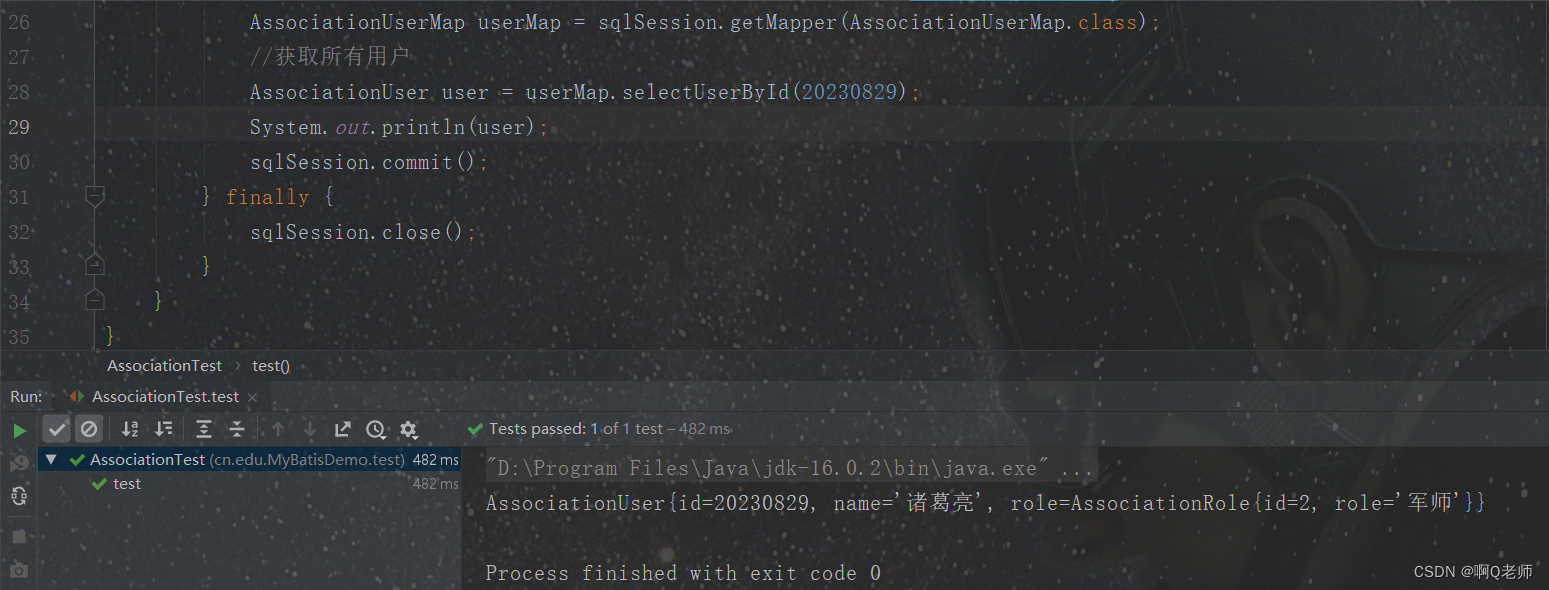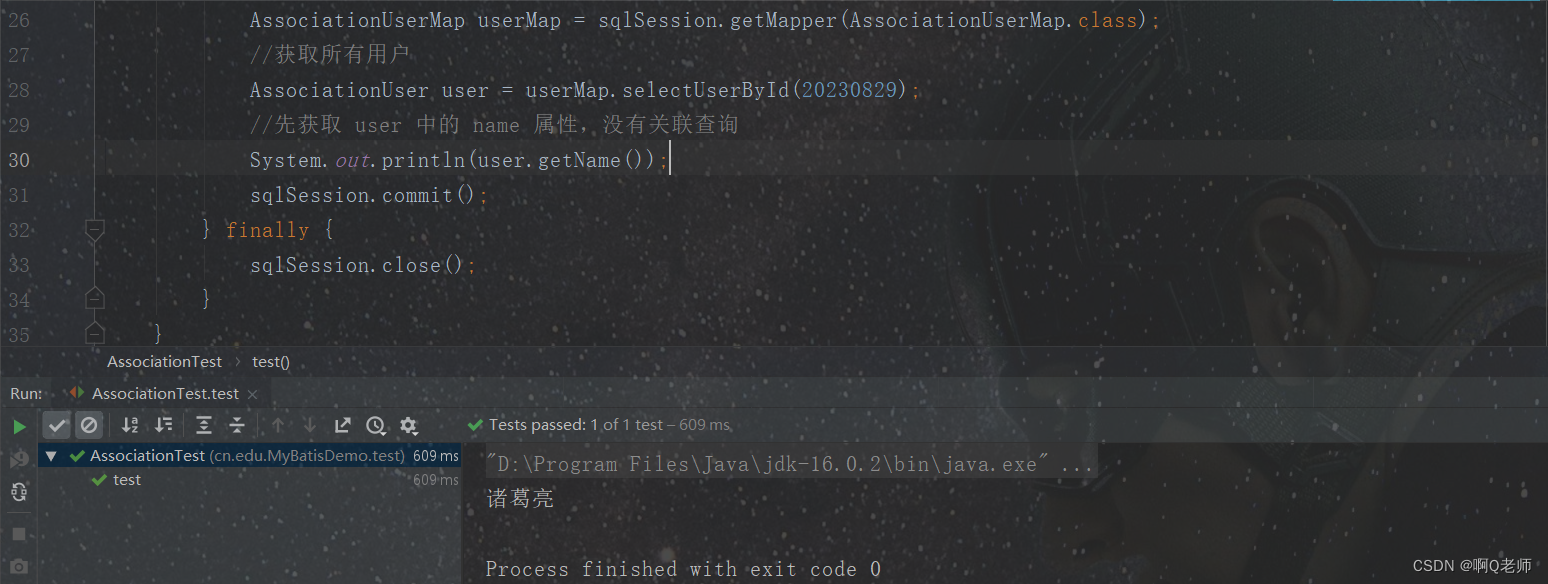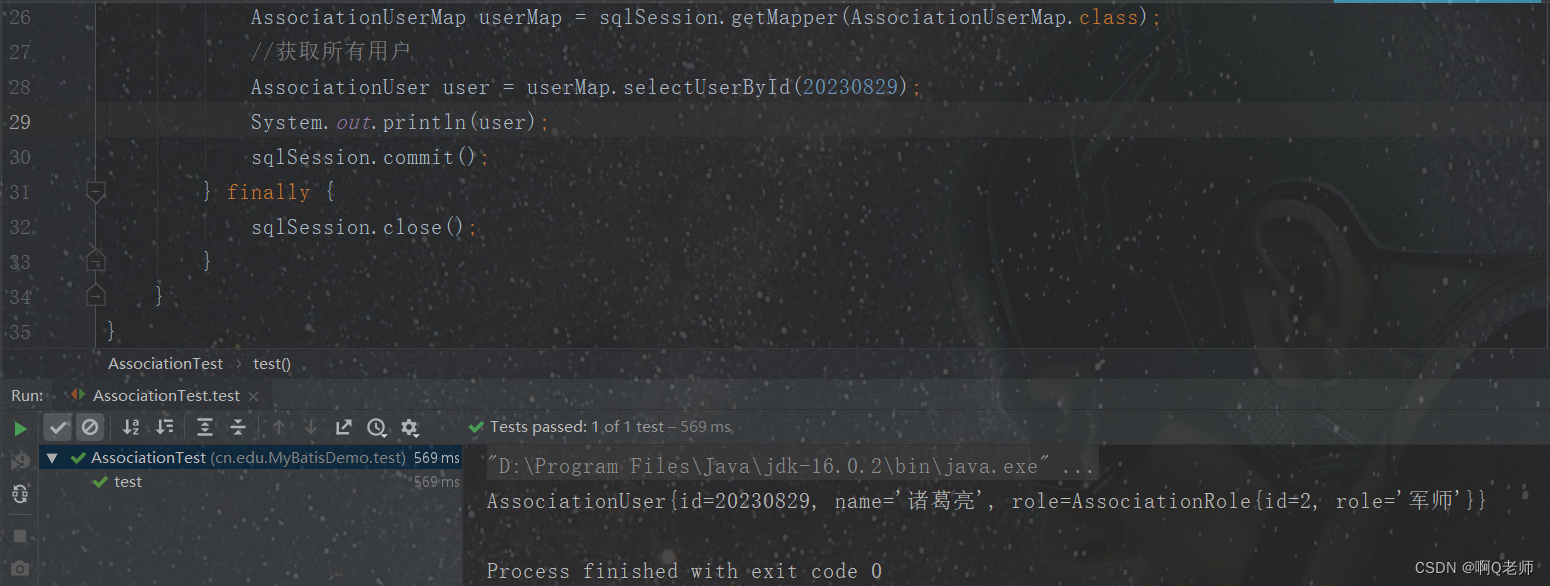MyBatis
- 前言
- 关联查询
- 附
- 懒加载
- 对象为集合时的关联查询

前言
在 MyBatis:配置文件 文章中,最后介绍了可以使用 select 标签的 resultMap 属性实现关联查询,下面简单示例
关联查询
首先,先创建 association_role 和 association_user 两张数据表,并建立关联关系
表结构如图:

表信息如图:

在创建 association_user 表时需要添加 association_role 表的关联字段( role_id )
表结构如图:

表信息如图:

接着,创建与两张数据表一一映射的实体类 AssociationRole 和 AssociationUser
// AssociationRole
package cn.edu.MyBatisDemo.model;public class AssociationRole {private int id;private String role;public AssociationRole() {super();}public AssociationRole(int id, String role) {this.id = id;this.role = role;}public int getId() {return id;}public void setId(int id) {this.id = id;}public String getRole() {return role;}public void setRole(String role) {this.role = role;}@Overridepublic String toString() {return "AssociationRole{" +"id=" + id +", role='" + role + '\'' +'}';}
}
// AssociationUser
package cn.edu.MyBatisDemo.model;public class AssociationUser {private int id;private String name;//添加 AssociationRole 属性private AssociationRole role; // AssociationRole -- 1:m -- AssociationUser (一对多关系)public AssociationUser(int id, String name, AssociationRole role) {this.id = id;this.name = name;this.role = role;}public AssociationUser() {super();}public int getId() {return id;}public void setId(int id) {this.id = id;}public String getName() {return name;}public void setName(String name) {this.name = name;}public AssociationRole getRole() {return role;}public void setRole(AssociationRole role) {this.role = role;}@Overridepublic String toString() {return "AssociationUser{" +"id=" + id +", name='" + name + '\'' +", role=" + role +'}';}
}
然后,创建一个接口 AssociationUserMap ,声明获取指定用户信息的方法。同时,创建映射文件 AssociationUserMap.xml 实现接口方法
// 接口 AssociationUserMap
package cn.edu.MyBatisDemo.mapper;import cn.edu.MyBatisDemo.model.AssociationUser;public interface AssociationUserMap {public AssociationUser selectUserById(int id); // 获取指定用户的信息
}
<?xml version="1.0" encoding="UTF-8" ?>
<!DOCTYPE mapperPUBLIC "-//mybatis.org//DTD Mapper 3.0//EN""https://mybatis.org/dtd/mybatis-3-mapper.dtd"><!-- 映射文件 AssociationUserMap.xml -->
<mapper namespace="cn.edu.MyBatisDemo.mapper.AssociationUserMap"><select id="selectUserById" resultMap="associationUser">SELECT user.id,user.name,user.role_id,role.roleFROM association_user USER,`association_role` roleWHERE user.role_id=role.id AND user.id=#{id}</select><!-- id 设置别名;type 指定类 --><resultMap id="associationUser" type="cn.edu.MyBatisDemo.model.AssociationUser" ><!-- 字段名对应的属性名 --><id column="id" property="id" /><result column="name" property="name" /><!-- 映射关联对象的属性 --><result column="role_id" property="role.id" /><result column="role" property="role.role" /></resultMap>
</mapper>
最后,测试结果
package cn.edu.MyBatisDemo.test;import cn.edu.MyBatisDemo.mapper.AssociationUserMap;
import cn.edu.MyBatisDemo.model.AssociationUser;
import org.apache.ibatis.io.Resources;
import org.apache.ibatis.session.SqlSession;
import org.apache.ibatis.session.SqlSessionFactory;
import org.apache.ibatis.session.SqlSessionFactoryBuilder;
import org.junit.Test;
import java.io.IOException;
import java.io.InputStream;public class AssociationTest {@Testpublic void test() throws IOException {//1.根据配置文件创建数据库连接会话的工厂类InputStream inputStream = Resources.getResourceAsStream("mybatis.xml");//获取工厂类SqlSessionFactory sqlSessionFactory = new SqlSessionFactoryBuilder().build(inputStream);//2.通过工厂类获取数据库连接的会话SqlSession sqlSession = sqlSessionFactory.openSession();//3.通过 sqlSession 操作数据库try {AssociationUserMap userMap = sqlSession.getMapper(AssociationUserMap.class);//获取所有用户AssociationUser user = userMap.selectUserById(20230829);System.out.println(user);sqlSession.commit();} finally {sqlSession.close();}}
}
结果如图:

附
懒加载
懒加载( Lazy Loading ),是在使用所需数据时才进行加载,而不是直接加载所有关联数据。这有利于提高查询性能和减少资源消耗。当一个实体类中包含关联对象(如一对多、多对多关系)时,使用懒加载可以避免在查询主对象时立即加载所有关联对象的数据,而是等到真正需要访问关联对象时才进行加载。
简单示例:
在上面案例的基础上,先通过使用 association 标签实现分步关联查询,再进行配置懒加载
首先,再创建一个接口 AssociationRoleMap ,声明获取指定用户信息的方法。同时,创建映射文件 AssociationRoleMap.xml 实现接口方法
package cn.edu.MyBatisDemo.mapper;import cn.edu.MyBatisDemo.model.AssociationRole;public interface AssociationRoleMap {public AssociationRole selectRoleById(int id); // 获取指定用户的信息
}
<?xml version="1.0" encoding="UTF-8" ?>
<!DOCTYPE mapperPUBLIC "-//mybatis.org//DTD Mapper 3.0//EN""https://mybatis.org/dtd/mybatis-3-mapper.dtd"><mapper namespace="cn.edu.MyBatisDemo.mapper.AssociationRoleMap"><select id="selectRoleById" resultType="associationRole">SELECT `id`,`role` FROM `association_role` WHERE `id`=#{id}</select>
</mapper>
接着,在映射文件 AssociationUserMap.xml 中,使用 association 标签实现关联查询。同时,修改 select 标签上的 SQL 语句
<?xml version="1.0" encoding="UTF-8" ?>
<!DOCTYPE mapperPUBLIC "-//mybatis.org//DTD Mapper 3.0//EN""https://mybatis.org/dtd/mybatis-3-mapper.dtd"><mapper namespace="cn.edu.MyBatisDemo.mapper.AssociationUserMap"><select id="selectUserById" resultMap="associationUser"><!-- 对比:分步关联查询的 SQL 语句相对简单些 -->SELECT `id`,`name`,`role_id` FROM `association_user` WHERE `id`=#{id}</select><!-- id 设置别名;type 指定类 --><resultMap id="associationUser" type="cn.edu.MyBatisDemo.model.AssociationUser" ><!-- 字段名对应的属性名 --><id column="id" property="id" /><result column="name" property="name" /><!-- 映射关联对象的属性 --><!-- <result column="role_id" property="role.id" /> --><!-- <result column="role" property="role.role" /> --><!-- 也可以使用子标签 association 实现关联查询 --><!-- property = 添加 AssociationRole 属性 role ;select = 关联对象映射文件中的方法 id ;column = 外键 --><association property="role" select="cn.edu.MyBatisDemo.mapper.AssociationRoleMap.selectRoleById" column="role_id" ></association></resultMap>
</mapper>
然后,在 pom.xml 配置文件中添加依赖包。同时,在 resources 目录下创建 log4j.properties 资源文件。目的是生成日志文件,方便观察理解
<!-- https://mvnrepository.com/artifact/log4j/log4j -->
<dependency><groupId>log4j</groupId><artifactId>log4j</artifactId><version>1.2.16</version>
</dependency>
#日志级别,分为八个级别( Off-关闭日志记录 > Fatal-严重错误 > Error-错误 > Warn-警告 > Info-运行信息 > Debug-调试 > Trace-低级信息 > All-所有日志记录)
#日志级别越高,过滤的信息越多#配置根节点
log4j.rootLogger=Debug,stdout,D
#配置控制台输出
log4j.appender.stdout=org.apache.log4j.ConsoleAppender
log4j.appender.stdout.Target=System.out
log4j.appender.stdout.Threshold=Error
##输出格式(%d %p [%1] %m %n——日期时间 类 路径 信息 换行)
log4j.appender.stdout.layout=org.apache.log4j.PatternLayout
log4j.appender.stdout.layout.ConversionPattern=%d %p [%l] %m %n#配置文件输出
log4j.appender.D=org.apache.log4j.DailyRollingFileAppender
log4j.appender.D.Append=true
log4j.appender.D.File=./log4j.log
log4j.appender.D.Threshold=Debug
#输出格式
log4j.appender.D.layout=org.apache.log4j.PatternLayout
log4j.appender.D.layout.ConversionPattern=%d %p [%l] %m %n
随之,在 resources 目录下的 mybatis.xml 全局配置文件中进行配置懒加载
<!-- 懒加载配置 -->
<settings><setting name="LazyLoadingEnabled" value="true"/><setting name="aggressiveLazyLoading" value="false"/>
</settings>
最后,测试结果
1.只获取 association_user 中的 name 属性(只加载所需要的数据,其他数据不加载)

查看日志,结果如图:

2.分步关联查询(加载所有关联数据)

查看日志,结果如图:

对象为集合时的关联查询
当关联查询的对象为集合时,与上面案例的主要区别为使用的是 collection 标签,而不是 association 标签。
简单示例:
首先,在实体类 AssociationRole 中添加 users 属性

接着,分别在接口 AssociationUserMap 和 AssociationRoleMap 中添加相应的方法


然后,分别在映射文件 AssociationUserMap.xml 和 AssociationRoleMap.xml 中实现相应的方法。同时在 AssociationRoleMap.xml 配置关联映射


最后,测试结果
结果如图:






:C/C++内存分布,C++内存管理方式)



)
连接数据库)








